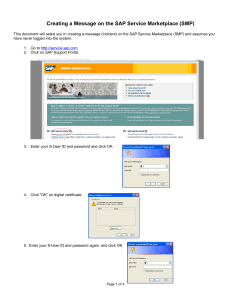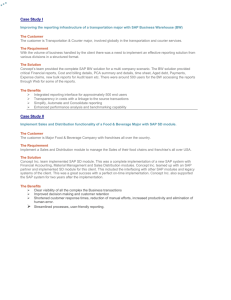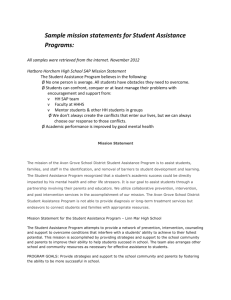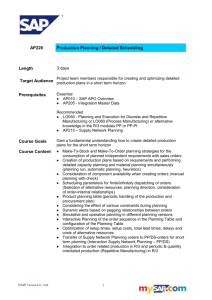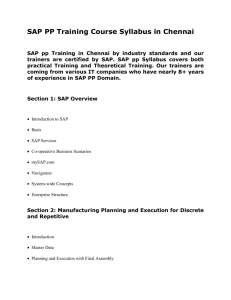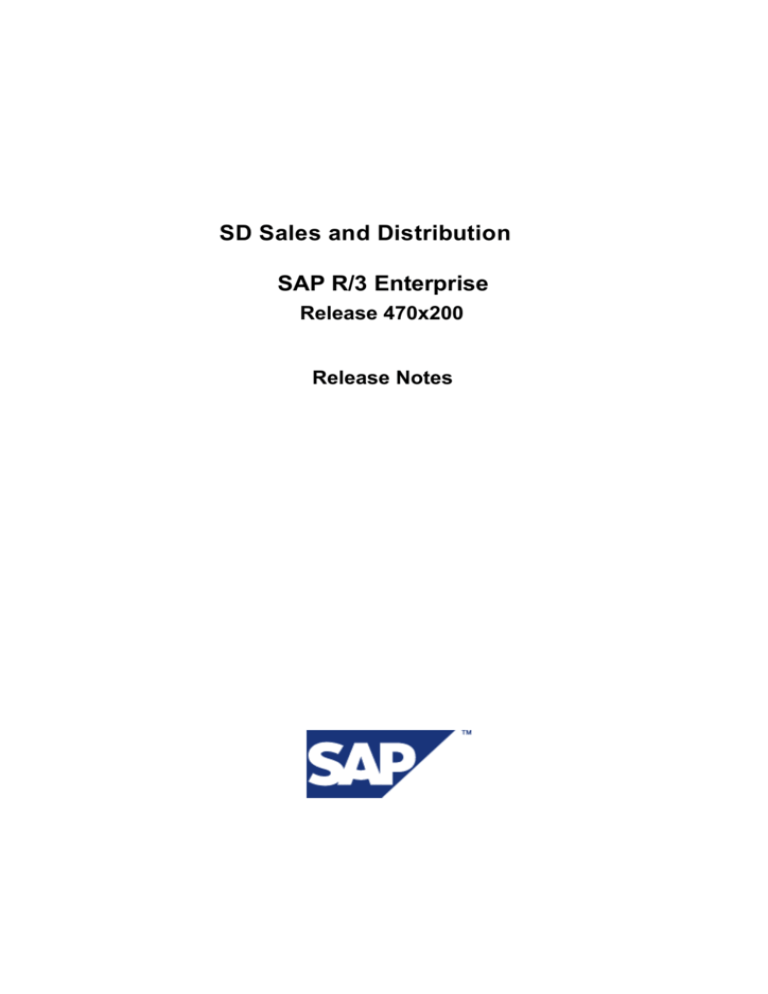
SD Sales and Distribution
SAP R/3 Enterprise
Release 470x200
Release Notes
© Copyright 2003 SAP AG. All rights reserved.
No part of this publication may be reproduced or transmitted in any form or for any purpose without the express permission
of SAP AG. The information contained herein may be changed without prior notice.
Some software products marketed by SAP AG and its distributors contain proprietary software components of other software
vendors.
Microsoft®, WINDOWS®, NT®, EXCEL®, Word®, PowerPoint® and SQL Server® are registered trademarks of
Microsoft Corporation.
IBM®, DB2®, OS/2®, DB2/6000®, Parallel Sysplex®, MVS/ESA®, RS/6000®, AIX®, S/390®, AS/400®, OS/390®, and
OS/400® are registered trademarks of IBM Corporation.
ORACLE® is a registered trademark of ORACLE Corporation.
INFORMIX®-OnLine for SAP and Informix® Dynamic Server
Incorporated.
TM
are registered trademarks of Informix Software
UNIX®, X/Open®, OSF/1®, and Motif® are registered trademarks of the Open Group.
Citrix®, the Citrix logo, ICA®, Program Neighborhood®, MetaFrame®, WinFrame®, VideoFrame®, MultiWin® and other
Citrix product names referenced herein are trademarks of Citrix Systems, Inc.
HTML, DHTML, XML, XHTML are trademarks or registered trademarks of W3C®, World Wide Web Consortium,
Massachusetts Institute of Technology.
JAVA® is a registered trademark of Sun Microsystems, Inc.
JAVASCRIPT® is a registered trademark of Sun Microsystems, Inc., used under license for technology invented and
implemented by Netscape.
SAP, SAP Logo, R/2, RIVA, R/3, SAP ArchiveLink, SAP Business Workflow, WebFlow, SAP EarlyWatch, BAPI,
SAPPHIRE, Management Cockpit, mySAP.com Logo and mySAP.com are trademarks or registered trademarks of SAP AG
in Germany and in several other countries all over the world. All other products mentioned are trademarks or registered
trademarks of their respective companies.
Design: SAP Communications Media
SAP
System
Table of Contents
SAP AG
______________________________________________________________
8
8.1
8.2
8.2.1
8.2.1.1
8.3
8.3.1
8.3.2
8.3.2.1
8.3.2.1.1
8.4
8.4.1
8.4.2
8.4.2.1
8.4.3
8.4.3.1
8.4.3.1.1
8.4.3.2
8.4.3.2.1
8.5
8.5.1
8.6
8.6.1
8.6.1.1
SD Sales and Distribution
Subcontracting with Chargeable Components (New)
SD-BF Basic Functions
SD-BF-AS Material Sorting
Material Sorting
SD-SLS Sales
Modifications to the Order BAPI in the Store Order
SD-SLS-RE Complaints
SD-SLS-RE-SR Sales Returns
Sales Returns
SD-BIL Billing
Complaints Processing (New)
SD-BIL-EM Empties Management
Empties Management
SD-BIL-RB Rebate Processing
SD-BIL-RB-PL Pendulum List Indirect Sales
Pendulum List
SD-BIL-RB-ENH Extended Rebate
Extended Rebate Processing
SD-EDI Electronic Data Interchange
Outbound Processing of PRICAT Messages (Changed)
SD-POS POS Interface
SD-POS-OUT POS Interface - Outbound
IDoc Copy Management
1
1
1
1
2
3
3
3
3
3
5
5
5
5
7
7
7
8
9
10
10
10
10
10
______________________________________________________________
SAP AG
iii
SAP System
______________________________________________________________
8 SD
Sales and Distribution
8.1 Subcontracting with Chargeable Components (New)
Use
As of SAP R/3 Enterprise Extension Set 2.00, companies in Japan can use the system to handle
subcontracting processes involving chargeable components.
The solution is based on the Subcontracting with Chargeable Components solution previously available
as an add-on from SAP Japan. The functions from the add-on are now part of the standard system. The
add-on has been discontinued.
You can now activate the solution for each valuation area separately. In the add-on, this was not possible.
Some of the programs available in the add-on are not available in the Extension Set. They are:
Program
Vendor Subcontracting Data Maintenance
Vendor/Customer Master Maintenance
Chargeable Info Record Maintenance
Customizing Program
Die Master Maintenance
Die Master Deletion
Die Master Reload
Technical Name
/SAPNEA/SAPMJSCA
/SAPNEA/SAPMJSCC
/SAPNEA/SAPMJSCD
/SAPNEA/SAPMJSCF
/SAPNEA/SAPMJSCB
/SAPNEA/J_SC_05
/SAPNEA/J_SC_07
For more details about the solution, see the SAP Library documentation listed below.
Effects on Customizing
In the IMG activity Activation Switch for SAP R/3 Enterprise Extension Set, activate Extension Set
EA-SCM.
Then carry out the IMG activities for Subcontracting with Chargeable Components in Customizing for
Materials Management (MM), by choosing Inventory Management and Physical Inventory ->
Subcontracting with Chargeable Components.
See also
SAP Note 641298
SAP Library -> SAP R/3 Enterprise Application Components -> Financials -> Country Versions ->
Asia-Pacific -> Japan -> Subcontracting with Chargeable Components
______________________________________________________________
SAP AG
1
SAP System
______________________________________________________________
8.2 SD-BF
Basic Functions
8.2.1 SD-BF-AS
Material Sorting
8.2.1.1 Material Sorting
Use
As of SAP R/3 Enterprise 2.00 (EA-APPL 200) you can use the Material Sorting component. In the
Material Sorting component, the system displays the material items on a document in the order you
specified in Customizing. The system sorts the material items of a document when the assigned form is
printed.
Each form can be assigned a sort variant that determines the sort sequence in the form. Each sort variant
can include up to six table fields. The name of the fields defines the criteria for sorting the material in the
document. The fields either come from the document item table (VBAP) or from the material master
(MARA).
The system sorts the main items and re-appends the subitems to the corresponding main items after
sorting. The system allocates the sorted items a new additional item number and writes the sorted items
back to the print structure.
Effects on Existing Data
Existing data is not affected.
Effects on Data Transfer
You must enter the forms before you make settings for material sorting otherwise the system does not
recognize the form and rejects it as an incorrect entry.
Effects on System Administration
There are no effects on system administration.
Effects on Customizing
The settings for material sorting are in the SAP Reference IMG under: <ZK>Sales and Distribution ->
Basic Functions -> Output Control -> Material Sorting.
To use material sorting, you must define the forms on which you want the system to take account of a
particular sequence of material items in Customizing.
You must make settings at the following points in Customizing:
o
Sort Variants
o
Material Sorting: Sales Documents
o
Material Sorting: Shipping Documents
o
Material Sorting: Groups
o
Material Sorting: Billing Documents
______________________________________________________________
SAP AG
2
SAP System
______________________________________________________________
See also
For more information on material sorting, see the SAP Library.
8.3 SD-SLS
Sales
8.3.1 Modifications to the Order BAPI in the Store Order
Use
In SAP R/3 Enterprise Retail 2.0 (EA-RETAIL 200) you can use the following functions in the Store
Order:
o
You can control whether SAP R/3 should round a purchase oredr quantity. In the outbound delivery
status, the rounding is activated. It is only for store goods receipts and load building that SAP R/3
does not perform rounding.
o
You can now transfer the net price in the condition table to the store order. However, you cannot
enter a condition type for this.
o
When calling the store goods receipt ot the purchase order copy, SAP R/3 does not trigger a
message control anymore. For all other applications that call the store order, the message control is
activated.
The additional functions are based in the PO_BAPI_CREATE1 BAPI enhancement.
See also
For more information about the Store Order, see the documentation on SAP Retail (SAP Library -> SAP
R/3 Enterprise Application Components -> Logistics -> SAP Retail) in the Purchasing area.
8.3.2 SD-SLS-RE
8.3.2.1 SD-SLS-RE-SR
Complaints
Sales Returns
8.3.2.1.1 Sales Returns
Use
As of SAP R/3 Enterprise 2.00 (EA-APPL 200) you can use the Sales Returns function. You can enter
sales returns for full products that have been returned by customers due to quality defects. The function
provides an accurate overview of the physical warehouse stock, and the corresponding postings and
analysis results.
The Sales Returns component in SAP R/3 Enterprise provides a user-friendly solution for managing the
______________________________________________________________
SAP AG
3
SAP System
______________________________________________________________
sales returns process:
o
You can enter the returns document with or without reference to a previous sales document.
o
To enter the analysis result, you can use the order items from the returns document as templates.
o
The system can allocate the order items from the returns document a result from the analyses and
settle them immediately. The result can be allocated to one item individually or to multiple items.
o
The system can check the entries for the analysis items to see if they are logical.
o
The system generates detailed logs and document flows showing the latest status of sales returns
processing.
Based on the result of the analysis, the system generates the relevant credit memos (SAP SD documents)
and the documents for the warehouse stock postings (SAP MM documents).
Effects on Existing Data
Existing data is not affected.
Effects on Data Transfer
The data transfer is not affected.
Effects on System Administration
If the system generates the follow-on documents in the background, you must schedule report
/BEV1/SR_BATCH_PROCESSING as a periodic background job. You should also maintain the
Customizing table Recipient for Express Mail for Background Processing.
Effects on Customizing
The settings for sales returns are in the SAP Reference IMG under:
Sales and Distribution -> Sales -> Sales Returns.
If you want to use the full scope of functions, you must make individual settings at the following points in
Customizing for sales returns:
o
Special document types for sales returns
o
Analysis key
o
Other informal analysis keys (for evaluations, statistics, and so on)
o
Refunding key
o
Analysis keys must be assigned to item categories
o
Order fields must be assigned to goods movements
o
Recipient for express mail for background processing
o
Filling facilities (for evaluations, statistics, and so on)
o
Content (for evaluations, statistics, and so on)
o
Keg lock (for evaluations, statistics, and so on)
The following settings must be made:
o
Document Types for Sales Returns
______________________________________________________________
SAP AG
4
SAP System
______________________________________________________________
o
Analysis Key
o
Refunding Key
o
Assign Analysis Key to Item Categories
See also
The special functions for sales returns are available in SAP EASY ACCESS under: Logistics -> Sales
and Distribution -> Shipping and Transportation -> Results of Sales Returns Analysis.
For more information, see the documentation on sales returns.
8.4 SD-BIL
Billing
8.4.1 Complaints Processing (New)
Use
As of SAP R/3 Enterprise Retail 2.00 (EA Retail 200), you can use the Complaints Processing function.
This function lets you enter a complaints reason and create all sales and billing documents with reference
to a billing document. You can change the quantity, unit of measure, material, and certain conditions in
the documents. A maximum of two documents can be generated for each complaints reason. You can also
display an overview of the documents that have already been generated for a billing document, such as
credit memos and returns.
Effects on Customizing
If you want to use the Complaints Processing function, you must first make the appropriate settings in
Customizing for Sales and Distribution under Billing -> Billing Documents -> Define Reasons for
Complaint.
See also
For more information, see the SAP Library under SAP R/3 Enterprise Application Component ->
Logistics -> Sales and Distribution -> Billing -> Complaints Processing.
8.4.2 SD-BIL-EM
Empties Management
8.4.2.1 Empties Management
Use
As of SAP R/3 Enterprise 2.00 (EA-APPL 200) you can use the Empties Management component. The
______________________________________________________________
SAP AG
5
SAP System
______________________________________________________________
Empties Management component is an enhancement of the SAP R/3 standard functions and deals with
the entry, processing, evaluation, and output of empties data from empties processing (in the beverage
industry, for example). You can use empties management to monitor and track the movement of empties
between vendor and customer. The component has its origins in the beverage industry and is now to be
used in other sectors.
The Empties Management component is available in SAP SD and offers the following functions:
o
Bills of material (BOMs) and trackability of empties
For all movements of the full product, the system keeps track of the corresponding empties in the
document items. This allows constant monitoring of the flow of empties, both within and outside of
the company. Using the BOMs of category 5, the system automatically assigns a full product (for
example, beer) the relevant empties (bottle or crate). The Empties Management component uses the
BOM explosion to show the dependency between full products and empties in the order.
o
Empties update and management of empties stock accounts
The empties update is an automatic, continuous, and up-to-date recording of all empties movements.
The data is only updated when billing takes place, thus defining a clear point for determining the
external status (that is, the empties stocks at the customer). The system manages the empties stock
accounts and updates empties movement data for the account holder. You determine a standard
partner role for the account holder (sold-to party (SP), ship-to party (SH), bill-to party (BP), or
payer (PY)). The system can keep track of the value and quantity of the empties stock, manage
empties as fixed assets or current assets, and manage empties deposits.
o
Check functions and output of empties stocks
Special forms and evaluations provide you with information about empties whenever you require it.
The aim of the check functions is to identify customers who have empties debts and notify them
accordingly.
By carrying out a value-based grouping of empties, the system can compile lists of all bottles that
are debited with the same amount (plastic bottles, glass bottles, and so on).
An empties block has been added to the SAP R/3 standard delivery note, allowing the system to
display empties (usually linked to the full product).
Empties can now also be printed on SAP R/3 standard invoices through the addition of an empties
block and an empties account.
The form Balance Confirmation for Monthly Empties Balances is a statement for the customer and
shows which empties were last moved for a period and when they were moved.
The Empties Evaluation Report is a statistical evaluation and can be used to sort and cumulate
empties data. The empties evaluation report is used primarily to evaluate empties data internally.
o
Archiving of data records from the empties tables
The files on which the empties update is based can be very extensive in production operation.
Archiving the data frees system capacities and improves performance. Only empties tables are
archived. There is no link to invoice archiving.
Effects on Existing Data
The volume of data has increased since new empties data is generated in the various empties table. In the
Basis empties table, the system generates one billing document record for each relevant empties item.
The data records are cumulated for monthly periods in the subsequentempties tables. By archiving the
system can reduce the dataset. However, the dataset should only be reduced if the system no longer
requires the empties data.
Effects on Data Transfer
______________________________________________________________
SAP AG
6
SAP System
______________________________________________________________
The data transfer is not affected.
Effects on System Administration
There are no effects on system administration.
Effects on Customizing
The settings for empties management are in the SAP Reference IMG under: Sales and Distribution ->
Billing -> Empties Update.
There is no delivery Customizing for the Empties Management component in the R/3 Enterprise
Extension Set 200 release.
See also
For more information on the Empties Management component, see the SAP Library.
8.4.3 SD-BIL-RB
Rebate Processing
8.4.3.1 SD-BIL-RB-PL
Pendulum List Indirect Sales
8.4.3.1.1 Pendulum List
Use
As of SAP R/3 Enterprise 2.00 (EA-APPL 200) you can use the Pendulum List component. The
Pendulum List component is used to enter indirect sales and sales volumes in the SAP R/3 System.
The Pendulum List component provides the following functions:
o
To simplify the confirmation of indirect sales or sales volumes for wholesalers, the system can
generate a request list on paper or as a file.
o
You can enter the indirect sales or sales volumes as confirmed by the wholesaler either manually or
automatically in the system.
o
The system can write the indirect sales or sales volumes manually or automatically to the Sales
Information System (SIS).
o
The requests and confirmations for indirect sales or sales volumes can be cancelled if required.
Effects on Existing Data
Existing data is not affected.
Effects on Data Transfer
The data transfer is not affected.
Effects on System Administration
______________________________________________________________
SAP AG
7
SAP System
______________________________________________________________
The creation of request lists, automatic entry of indirect sales or sales volumes, and update of indirect
sales or sales volumes can be started as background jobs.
Effects on Customizing
The settings for the pendulum list are in the SAP Reference IMG under: Sales and Distribution ->
Pendulum List Indirect Sales.
To use the full scope of the pendulum list, you must make settings at the following points in
Customizing:
Pendulum List Indirect Sales
o
o
o
General Settings
-
Maintain Role Assignments
-
Maintain Origin Indicator
-
Maintain Interface Control
-
Maintain Document Types for Indirect Orders
-
Maintain Function Module Call for Order Creation
-
Define and Assign Status
-
Maintain Control Definitions
- Transport Control Definitions
- Transport Control Definitions 2
Output Control
-
Assign Higher-Level Sales Organization
-
Assign Sales Organization for Output
-
Assign Output Mediums
-
Maintain Output Files and Directories
Define Periods
-
Define and Assign Period Control
- Maintain Period Split
- Maintain Period Groups
-
Maintain Period Table
See also
The special functions for the pendulum list are in SAP EASY ACCESS under: Logistics -> Sales and
Distribution -> Pendulum List Indirect Sales.
For more information on the pendulum list, see the SAP Library.
______________________________________________________________
SAP AG
8
SAP System
______________________________________________________________
8.4.3.2 SD-BIL-RB-ENH
Extended Rebate
8.4.3.2.1 Extended Rebate Processing
Use
As of SAP R/3 Enterprise 2.00 (EA-APPL 200) you can use the Extended Rebate Processing component.
The Extended Rebate Processing component is an integrated enhancement of the standard rebate
functions.
Extended Rebate Processing provides the following functions that are integrated with the standard rebate
processing:
o
More flexible rebate settlement using a variable key in the rebate information structure.
When the rebate information structure is updated, the system can include selected data from the
billing documents in the variable key. The system transfers this data to the billing document when
the credit memo is created. This means that the system can transfer the rebate-incurring material to
the credit memo instead of the settlement material. The system can transfer partners from the billing
documents, allowing multiple rebate recipients for one and the same condition.
o
Periodic settlement of rebate agreements.
Instead of the previous periodic partial settlement, which always took the entire validity period of an
agreement into account, the system can now also carry out partial settlements where it only takes
account of the individual period for the settlement. The system settles individual periods like
separate agreements, especially regarding the use of scales and fixed amounts.
o
Handling of indirect rebate agreements.
By using pro forma billing documents, the system makes indirect data available for rebate
processing. With special calculation types and condition formulas, the system can use planning data
to form accruals and actual data for rebate settlement.
o
The new functions are fully integrated into the standard system, unlike the existing
beverage-specific enhancements. This means that many of the previous restrictions in rebate
processing no longer apply. The system can use the condition exclusion, condition basis formulas,
condition value formulas, and the exclusive condition access in the access sequence. There are no
restrictions either in the use of calculation types and scale indicators.
Effects on Existing Data
Existing agreements are not affected by extended rebate processing. There are no effects on existing data.
Effects on Data Transfer
There are no effects on the data transfer.
Effects on System Administration
If the existing solutions are replaced by the extended rebate processing, you may have to schedule new
background jobs. This applies to the settlement using the new procedure and also to the update of indirect
sales from the customer-specific information structure.
New forms are usually required for the rebate settlement due to the different data structure.
Effects on Customizing
______________________________________________________________
SAP AG
9
SAP System
______________________________________________________________
o
The settings for Extended Rebate Processing are in the SAP Reference IMG under: Sales and
Distribution -> Billing -> Rebate Processing -> Extended Rebate Processing.
o
Existing Customizing settings are not affected.
o
The new rebate procedure as of Release 4.6A in the standard must be activated before you can use
Extended Rebate Processing.
o
Extended Rebate Processing is activated using the rebate information structure S469.
o
New order types and billing types are delivered for rebate settlement, as are item categories, copying
control, and relevant assignments.
o
The pricing procedure BVRBTI and the condition formula 329 are delivered for updating indirect
sales.
See also
For more information on Extended Rebate Processing, see the SAP Library.
8.5 SD-EDI
Electronic Data Interchange
8.5.1 Outbound Processing of PRICAT Messages (Changed)
Use
As of SAP R/3 Enterprise Retail 2.00 (EA-RETAIL 200) there is a change management function
available in the outbound processing of the price catalog (transaction VPRICAT). You can use this
function to copy and copy master data, user-specific fields and planned changes in the price catalog.
You can also display these user-specific fields and send them in the PRICECATALOGUE02 IDoc.
There are also new BAdIs available for filling the price catalog.
8.6 SD-POS
8.6.1 SD-POS-OUT
POS Interface
POS Interface - Outbound
8.6.1.1 IDoc Copy Management
Use
As of SAP R/3 Enterprise Retail 2.0 (EA-RETAIL 200) you can have the system copy outbound
IDocs for specified recipients from the existing IDocs of particular recipients. You do not have to have
the system generate assortment lists for all stores, for example. Instead, you can have them generated for
a few reference stores. Finally, you can copy their outbound IDocs in accordance with particular rules
from the existing outbound IDocs. This can greatly improve performance.
______________________________________________________________
SAP AG
10
SAP System
______________________________________________________________
You can use a BAdI to change the reference IDoc if necessary.
See also
For more information, see the SAP Retail documentation (SAP Library-> SAP R/3 Enterprise
Application Components -> Logistics -> SAP Retail) under the area Distributed Data Processing -> POS
Interface -> POS Interface - Outbound.
______________________________________________________________
SAP AG
11



